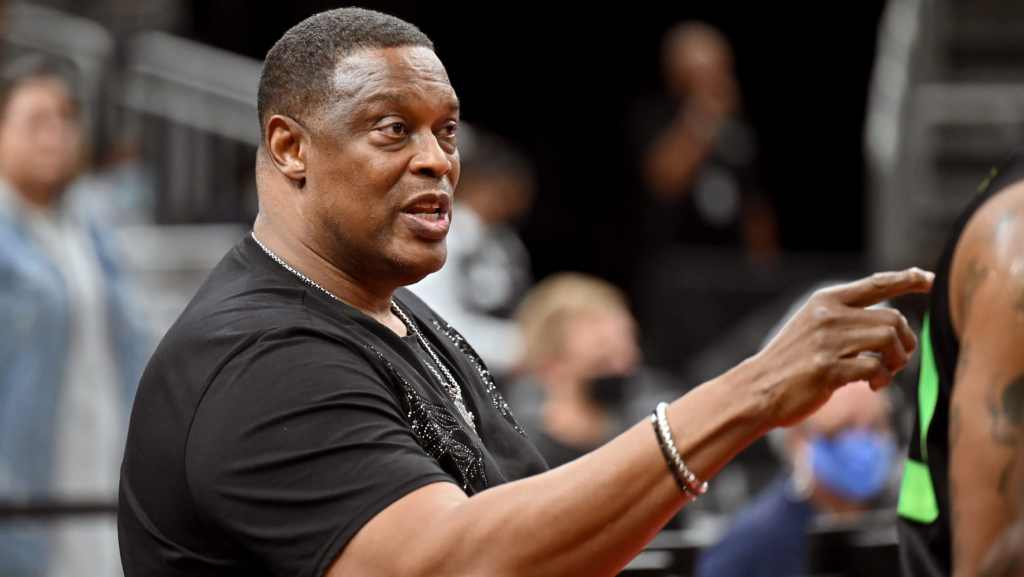
Rick Mahorn has always told it like it is. Whether he was anchoring the paint as a core member of the Bad Boy Detroit Pistons, sharing locker rooms with legends in New Jersey, or breaking down the evolution of today’s NBA, Mahorn doesn’t pull punches — and in a sit-down, he brought that same raw honesty. He’s the kind of voice that echoes what fans think but players know — the inside grit, the locker room politics, the blood-and-bone sacrifices made long before cameras were everywhere. You can hear the passion in his delivery, see the memories dance behind his eyes, and sense that he carries the game’s history like a badge of honor. For Mahorn, basketball isn’t just a game — it’s a mirror of life, of roles accepted, of moments seized or missed. When he talks about today’s Pistons, the glory days of the Bad Boys, or fallen teammates like Dražen Petrović, you don’t just listen — you lean in. Because when Rick Mahorn speaks, the truth always shows up in full uniform.
ON THE PISTONS’ PROGRESS & TOGETHERNESS
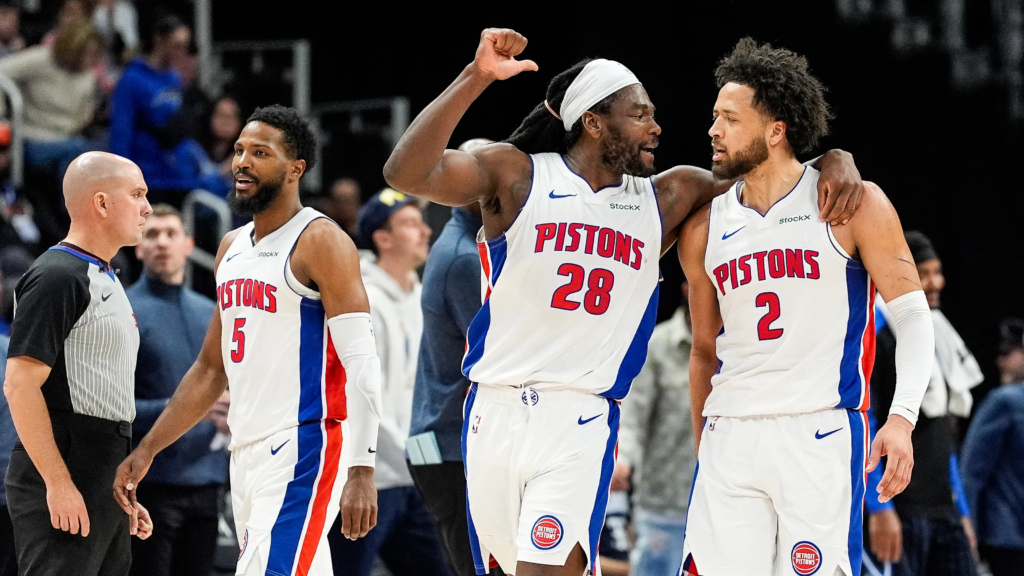
As the Detroit Pistons enter a new chapter with a retooled front office and fresh talent, Mahorn sees signs of real cohesion.
“It seems that they have a togetherness about them,” said Mahorn. “It seems like the veteran leadership is very contagious with Tobias Harris, Malik Beasley and Tim Hardaway Jr. and then the rookies are responding with Ausar Thompson and Ron Holland.”
“You gotta credit — it starts from the top. Trajon [Langdon] did a great job coming in his first GM year to hire a guy like J.B. Bickerstaff… His record has shown. Nobody gives him that type of credit from Houston and when he took over Cleveland. He has a pedigree with his dad, Bernie Bickerstaff. I’ve known him since he was a kid. And so to see his relationship with the players is more about making sure they’re on the right page.”
Even with Cade Cunningham and Jaden Ivey dealing with injuries, Mahorn praised the team’s sacrifice and resiliency.
BAD BOYS COMPARISON? NOT YET.
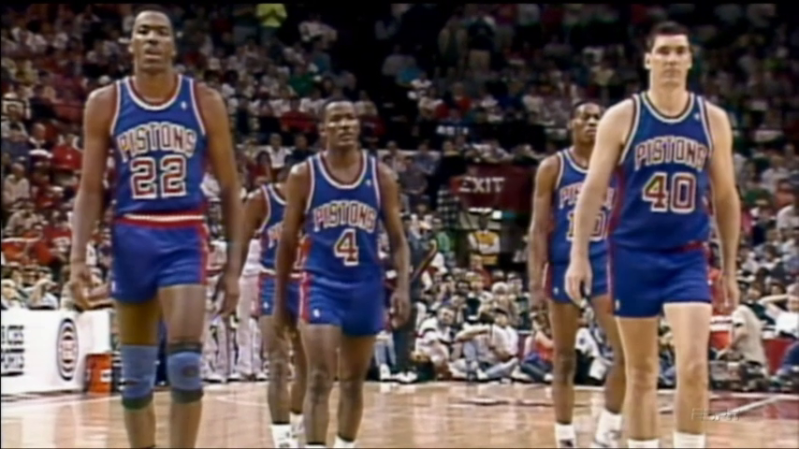
The “Bad Boys” Detroit Pistons, led by Coach Chuck Daly, were one of the most formidable and feared teams in NBA history. Known for their tough, physical style of play, the Bad Boys set a new standard for defense and grit, with players like Isiah Thomas, Joe Dumars, Dennis Rodman, and Rick Mahorn embodying the team’s aggressive, no-nonsense attitude. Mahorn, in particular, was a key figure in the team’s success, serving as the enforcer who set the tone with his bruising defense and willingness to battle in the paint. His tough mentality on the court, combined with his smart, physical play, helped the Pistons dominate the Eastern Conference during the late 1980s and early 1990s. The Bad Boys’ defensive prowess, highlighted by their “Jordan Rules” strategy to slow down Michael Jordan, paved the way for back-to-back NBA championships in 1989 and 1990. As part of this legendary group, Mahorn’s presence was vital to the Pistons’ identity, contributing not only to their success on the court but also to their reputation as the most feared team of the era.
The 2004 Detroit Pistons were a team that defied expectations and proved that team basketball could overcome individual star power. Under the leadership of coach Larry Brown, the Pistons were built on defense, unselfish ball movement, and a deep, balanced roster. With key players like Chauncey Billups, Ben Wallace, Richard Hamilton, Tayshaun Prince, and Rasheed Wallace, the Pistons played with a collective determination and toughness that made them a nightmare for any opponent. Ben Wallace, named NBA Defensive Player of the Year, anchored one of the league’s best defenses, while Billups, known as “Mr. Big Shot,” provided clutch scoring and leadership in crucial moments. The team’s victory in the 2004 NBA Finals, where they defeated the heavily favored Los Angeles Lakers in a five-game series, marked a stunning achievement in franchise history. The Pistons’ triumph was a testament to the power of cohesion and selflessness, proving that a team-oriented approach could lead to the ultimate success.
Asked if this year’s Pistons resemble past champions — the Bad Boys or the 2004 title team — Mahorn was clear:
“I mean… you can’t. You’re talking two champions. Until you get a ‘chip, I can’t compare it.”
Still, he acknowledged Cade’s All-Star caliber leadership:
“Cade Cunningham — the way he’s playing, helping guys understand how to get involved — that’s one thing you can compare. Now their defense is getting better… but we’re talkin’ Ben Wallace, Rodman, Salley. That’s a different level.”
CADE’S GROWTH: THE RIGHT HAND OF J.B.
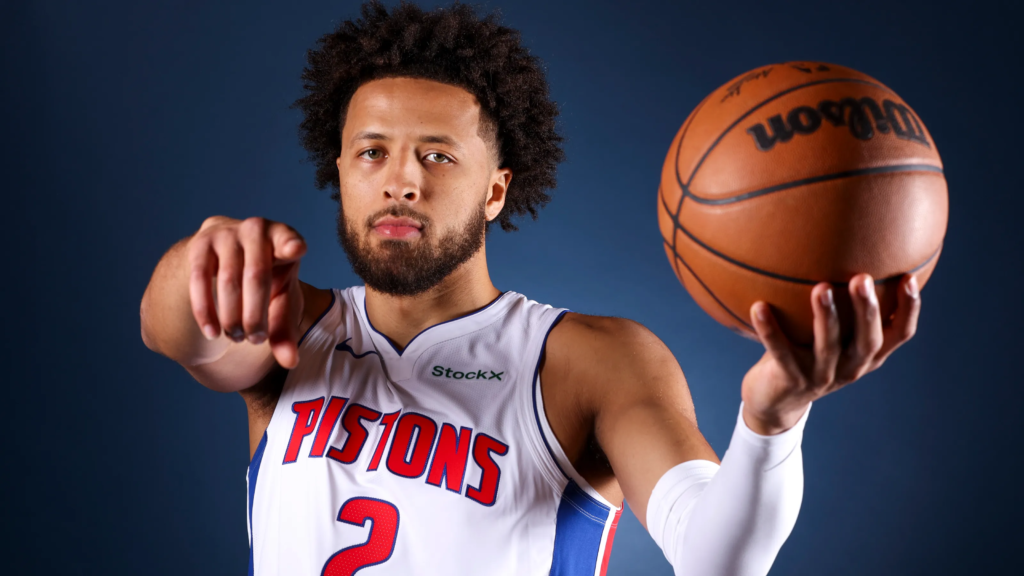
Cade Cunningham is widely regarded as one of the most promising young talents in the NBA. As the first overall pick in the 2021 NBA Draft, Cunningham quickly established himself as the cornerstone of the Detroit Pistons’ rebuild. Known for his poise, court vision, and basketball IQ, Cunningham has the ability to impact the game in multiple facets, from scoring to playmaking to defense. His versatility as both a point guard and shooting guard allows him to be effective in various offensive systems, and his leadership qualities have already made him a vocal presence on the court. Cunningham’s growth is a key to their success, especially with his ability to elevate the play of his teammates. Despite some injury setbacks early in his career, Cunningham’s potential is undeniable, and many expect him to become one of the league’s top stars in the coming years.
Mahorn sees leadership maturing in Cade Cunningham:
“I think it’s more of the divvying and understanding what plays should be run because he’s the right hand of J.B. Bickerstaff. He has the familiarness of being with Duren, also with Ivey, knowing their sweet spots. That’s the thing about maturing in the NBA — becoming a point guard in this league.”
NETS MEMORIES: FROM LOCKERS TO LEADERSHIP
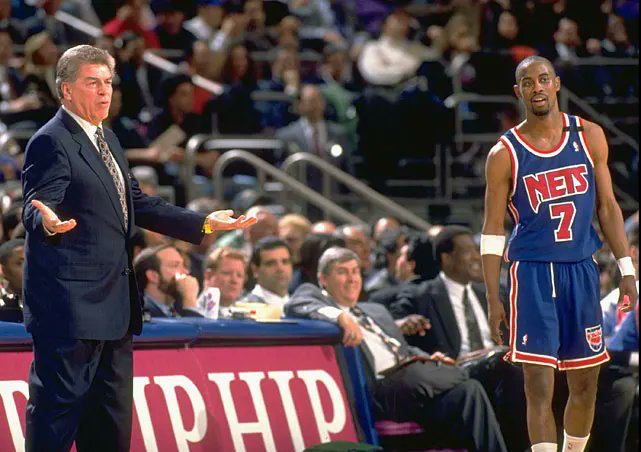
The New Jersey Nets of the early 1990s, with Derrick Coleman, Kenny Anderson, and Chuck Daly at the helm, were a team brimming with potential but plagued by inconsistencies. Derrick Coleman, the team’s talented yet enigmatic forward, was the centerpiece, known for his unique combination of size, skill, and basketball IQ. He could stretch the floor, dominate in the post, and rebound with authority, but his sometimes erratic play prevented him from fully reaching his immense potential. Kenny Anderson, a gifted point guard with exceptional vision and passing ability, ran the offense and showed flashes of brilliance, though he too was occasionally inconsistent. Head coach Chuck Daly, who had led the Detroit Pistons to two championships, was tasked with trying to instill discipline and a winning mentality in a team full of youthful promise. While Daly’s presence brought a level of experience and structure, the Nets struggled to put it all together, never truly living up to the expectations set by their individual talents. Despite their challenges, the squad featured plenty of intrigue, with Anderson’s creativity and Coleman’s skill making them one of the more exciting teams to watch in the league during that time.
After his iconic run with the Detroit Pistons, Rick Mahorn joined the New Jersey Nets, bringing his veteran leadership, toughness, and defensive prowess to a team in transition. While the Nets had a promising young core with Derrick Coleman and Kenny Anderson, they lacked the grit and experience to make a serious impact. Mahorn, who was known for his enforcer role with the “Bad Boys” Pistons, offered a different dynamic to the Nets. His presence on the floor was felt immediately, as he brought a sense of toughness and accountability to a team that was still finding its identity. Mahorn’s leadership was especially valuable off the court, where his mentorship of younger players, including Coleman, was crucial in helping them understand the nuances of being a professional and playing with discipline. Though Mahorn’s time with the Nets was relatively short, his impact on the locker room and his defensive presence on the court left a lasting impression, bridging the gap between the Pistons’ championship pedigree and the Nets’ potential.
One of the more significant challenges they faced was the lack of a dedicated practice facility, a luxury that many teams today take for granted. The Nets were forced to make do with alternative arrangements, often practicing at local venues like Oakland University or even makeshift spaces. For players like Rick Mahorn, this lack of modern amenities didn’t dampen their love for the game. As Mahorn recalled, “When you’re playing basketball and you love the game, you don’t give a [expletive] where you are. You just want to hoop!” The absence of a practice facility highlighted the financial constraints the team faced, but it also fostered a sense of grit and determination. Players had to adjust, finding ways to make the most of the limited resources available to them. Despite these obstacles, the team’s resolve remained strong, with veterans like Mahorn leading the way and helping the younger players adjust to the realities of life in the NBA. The Nets’ struggle to secure a practice facility in the 90s became a symbol of their perseverance during a challenging decade for the franchise.
Mahorn on the Nets’ gritty practice conditions:
“Nobody had a gym. We practiced at Oakland University. People think we had bells and whistles — shoot, Paul Silas used to practice at the YMCA. But if you love the game? You just wanna f***in’ hoop!”
“We didn’t share lockers, but we did share the locker room — it was a men’s locker room, not the Beverly Hills Club!”
P.J. BROWN, PROFESSIONALISM & SACRIFICE

P.J. Brown, a retired NBA veteran, is best remembered for his consistency, toughness, and professionalism throughout his long career in the league. After being drafted by the New Jersey Nets in 1992, Brown spent 18 seasons with several teams, including the Charlotte Hornets, Miami Heat, and Boston Celtics, solidifying his reputation as a key contributor on both ends of the floor. Known for his solid defense, rebounding, and leadership, Brown was the epitome of a player who didn’t need the spotlight but still made his presence felt. His ability to fill the gaps on offense while anchoring defenses made him a valuable asset to every team he played for. Brown’s basketball IQ and no-nonsense approach to the game earned him the respect of teammates and opponents alike, and he was crucial to the Heat’s 2006 championship run. Beyond his playing career, Brown became a symbol of the professional role player who understood the importance of sacrifice, often mentoring younger players and offering his wisdom in the locker room.
Mahorn spoke reverently about his former Nets teammate:
“That’s my man! He came in with bright eyes and just wanted to play. That’s what made him last in the league. Every player has to sacrifice.”
Mahorn also reflected on whether there were any modern versions of PJ Brown in today’s NBA:
“David West was like that. Professionals. Bruce Bowen was a professional. Some people now just don’t want to accept their roles.”
DRAYMOND GREEN & DENNIS RODMAN COMPARISONS
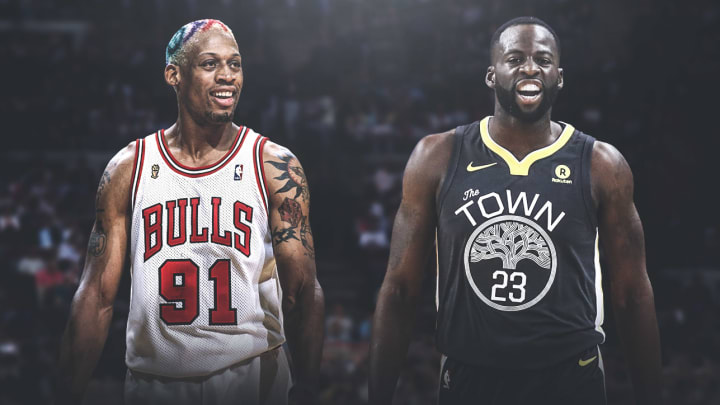
Draymond Green and Dennis Rodman, though from different eras, share striking similarities in their roles on the basketball court, both known for their intense defense, rebounding prowess, and unique personalities. Rodman, one of the NBA’s greatest rebounders, earned his reputation with his relentless hustle, exceptional positioning, and unmatched ability to guard multiple positions, becoming a key figure in the Chicago Bulls’ championship runs in the 1990s. Green, much like Rodman, has been a defensive anchor for the Golden State Warriors, bringing intensity, versatility, and leadership to the team. While Rodman’s rebounding and defense were his primary strengths, Green has evolved to become an elite playmaker and facilitator, showcasing his ability to influence the game in multiple ways. Both players have also been known for their emotional and sometimes controversial on-court behavior, yet their passion and tenacity have made them indispensable to their teams’ success. Despite their differences in style, both Rodman and Green are defined by their willingness to embrace their unique roles and sacrifice for the team, making them invaluable assets in their respective eras.
Mahorn believes Draymond Green would’ve fit in just fine in his era:
“Could he have played in our era? He’s a basketball player. He learned from the Bad Boys. A Flintstone native… It’s not different, he’s just incorporating his style.”
THE NY/NJ RIVALRY & CULTURE CLASHES
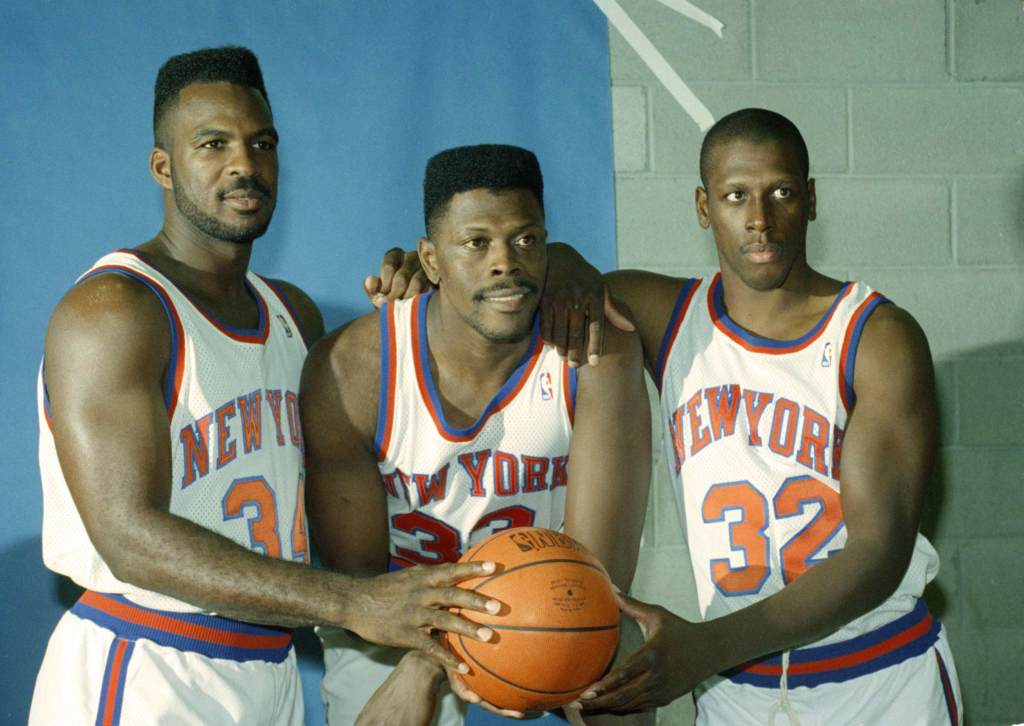
The rivalry between the New Jersey Nets and New York Knicks in the early 90s was an intriguing yet somewhat understated chapter in NBA history. While the intensity of the Knicks’ rivalries with teams like the Chicago Bulls and Miami Heat often stole the spotlight, the Nets’ proximity to New York City and their own competitive spirit set the stage for some fierce matchups. The Knicks, led by Patrick Ewing and coached by Pat Riley, were in their prime, and the Nets, with players like Derrick Coleman and Kenny Anderson, were building their own identity. However, while there were moments of tension and some spirited games, the rivalry never quite reached the same level as others in the era. The Knicks were consistently seen as the superior team, which diminished the “true” rivalry from a competitive standpoint. Still, the geographical proximity and the fact that both teams played in the same media market made for a natural, albeit one-sided, rivalry. Whether it was the Knicks’ dominance or the Nets’ struggles, the rivalry lacked the consistent, high-stakes drama that defined other NBA rivalries of the time. Ultimately, while the rivalry existed in the sense of city pride, it didn’t hold the same weight as others in the NBA landscape during the 90s.
Mahorn reflected on it:
“You’re in the same city! You’re gonna run into them at a restaurant, a nightclub, strip club — whatever! You build relationships, but you always wanted to beat the team everybody was rooting for.”
YINKA DARE, WILLIS REED & FRONT OFFICE RESPECT

Yinka Dare, a towering presence at 7 feet tall, was a raw and physical force during his time in the NBA. Known for his imposing size and potential, Dare was a late-bloomer in terms of basketball development, having come into the league with limited experience and refinement in his game. Despite his raw talent, he struggled to fully tap into the potential many saw in him, particularly in terms of his offensive game and basketball IQ. As a shot-blocker and rebounder, he showed flashes of the dominant presence that could have made him a fixture in the league. Tragically, Dare never fully realized the greatness that many expected from him, but his work ethic and determination left a lasting impression on those who saw him play. His story serves as a reminder of the delicate balance between physical gifts and the mental and technical growth required to succeed at the highest level of basketball.
“He had the body of a goliath… but sometimes it just never clicked in his mind,” recounted Mahorn.
Willis Reed’s role with the New Jersey Nets was a significant and transformative one, even though he was far removed from his playing days. After his illustrious career with the New York Knicks, where he earned his legendary status as a two-time NBA champion and Finals MVP, Reed transitioned to a front-office role with the Nets. As an executive, he provided invaluable leadership and insight, drawing on his experience as a player and his understanding of the game at a deeper level. His presence was especially important in guiding the Nets during a time of transition, helping the team navigate the complex dynamics of the NBA. Although Reed’s playing days were behind him, his impact on the Nets was profound, helping to shape the franchise’s culture and making him a key figure in the team’s history. His legendary status as a Knicks hero also gave him a unique perspective in building relationships with players and management, ultimately contributing to the Nets’ development during his tenure.
Mahorn on Willis Reed as a Nets exec:
“Number 19 was my hero! From Grambling. That’s what gave me hope as a kid from Hampton. It’s hard transitioning from court hero to front office leader. But guys like Joe Dumars made it happen.”
BUTCH BEARD & DERRICK COLEMAN’S BLANK CHECK MOMENT
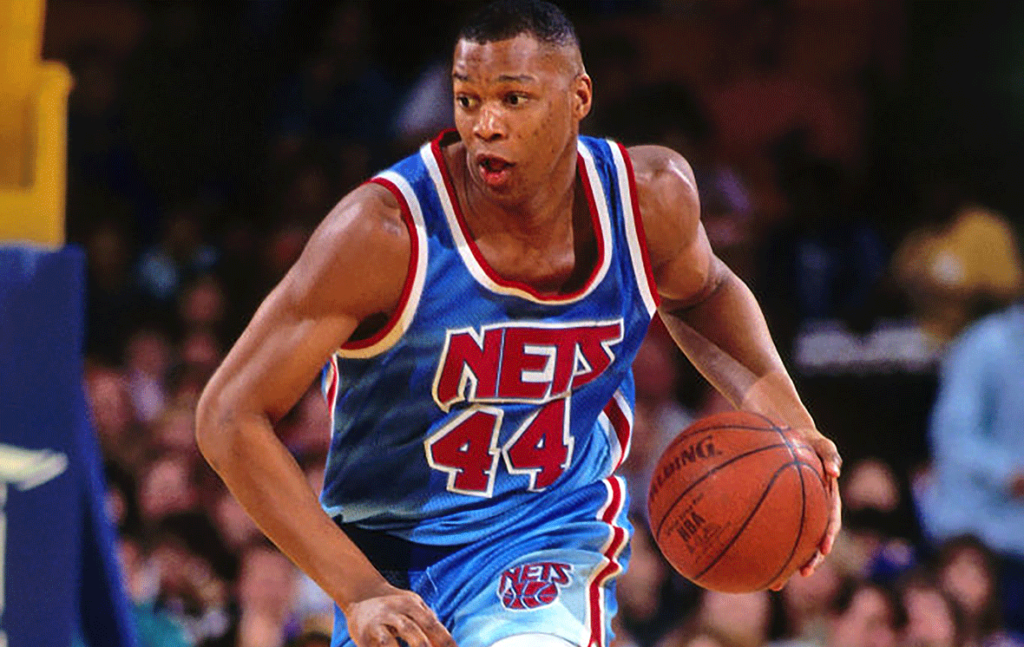
When Butch Beard took over as head coach of the New Jersey Nets in the early 90s, he introduced a strict dress code for players, aiming to instill a sense of professionalism and discipline within the team. The mandate required players to travel to games dressed in suits, specifically with jackets and ties, which was a common practice in the NBA at the time. However, the dress code quickly became a point of contention, particularly with star player Derrick Coleman, who was outspoken about his resistance to the rule. Coleman, known for his rebellious personality, didn’t take kindly to the imposition of a formal dress code, and he made his stance clear. In a bold move, when Coach Beard announced fines for any player who didn’t adhere to the dress code while traveling, Coleman decided to push back in his own way. He handed Beard a blank check, signaling that he was willing to pay any fine imposed rather than comply with the mandate. This rebellious gesture became a symbol of the tension between Coach Beard’s attempts at enforcing discipline and Coleman’s unfiltered attitude, illustrating the clash of personalities that defined the era for the Nets. Despite the conflict, the situation also reflected the evolving dynamics of player-coach relationships in the NBA, where individuality often collided with team expectations.
Why?
Butch Beard… Alfred, you know I knew him before they named him Butch or Butchy or whatever but, the black check was to say, Look. I’m gonna do what I wanna do and be independent, but I’m NOT gonna wear a suit… but now, you don’t even have to wear a suit, you know what I mean? You can go there in your drawers! I’m goin’ down on the court in my drawers [laughing] but it’s a time that you look at it and go like, It was just one of those times that this is Derrick Coleman’s team and this is what DC was gonna do.
DRAŽEN PETROVIĆ: THE PROTOTYPE
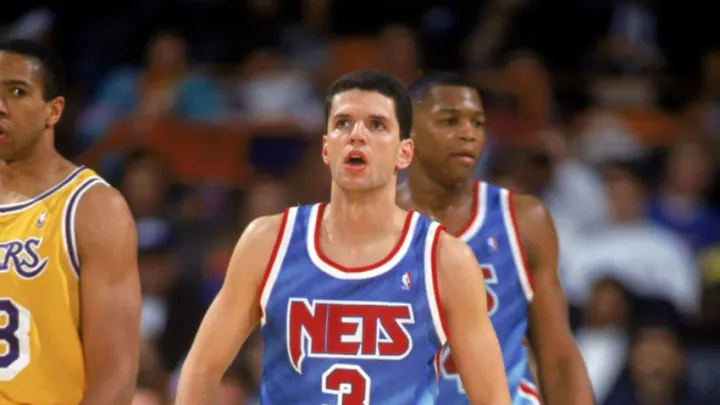
Dražen Petrović was more than just a trailblazer for international players—he was a fierce competitor, a fearless scorer, and a cultural icon who brought European flair and fire to the NBA hardwood. Known as the “Mozart of Basketball,” Petrović arrived in the league from Croatia with a reputation as a prolific scorer overseas, but had to fight for playing time in Portland before finding his stride with the New Jersey Nets. Once in New Jersey, Dražen erupted—averaging over 20 points per game, hitting clutch shots, and earning the respect of peers across the league for his toughness and relentless work ethic. His swagger, combined with a burning desire to prove that European players belonged in the NBA, made him a symbol of pride for many and a pioneer who helped pave the way for future generations of international stars. Tragically, his life and career were cut short in a 1993 car accident, but his legacy still burns bright—etched into Nets history and international basketball lore forever.
Mahorn lit up when talking about the late, great Dražen Petrović:
“Man… that brings back some great memories. He was the third or fourth best 2-guard in the league at that time. It was like every time I set a pick for him, he’d say, ‘That was for YOU Rick Mahorn!’ I’m like, ‘I didn’t think you were gonna pass it to me anyway!’ [laughs]”
“It was fundamentals. If he played today? He’d be a MONSTER.”
ON SABONIS, DIVAC, & THE JOKER’S WATER POLO SKILLS
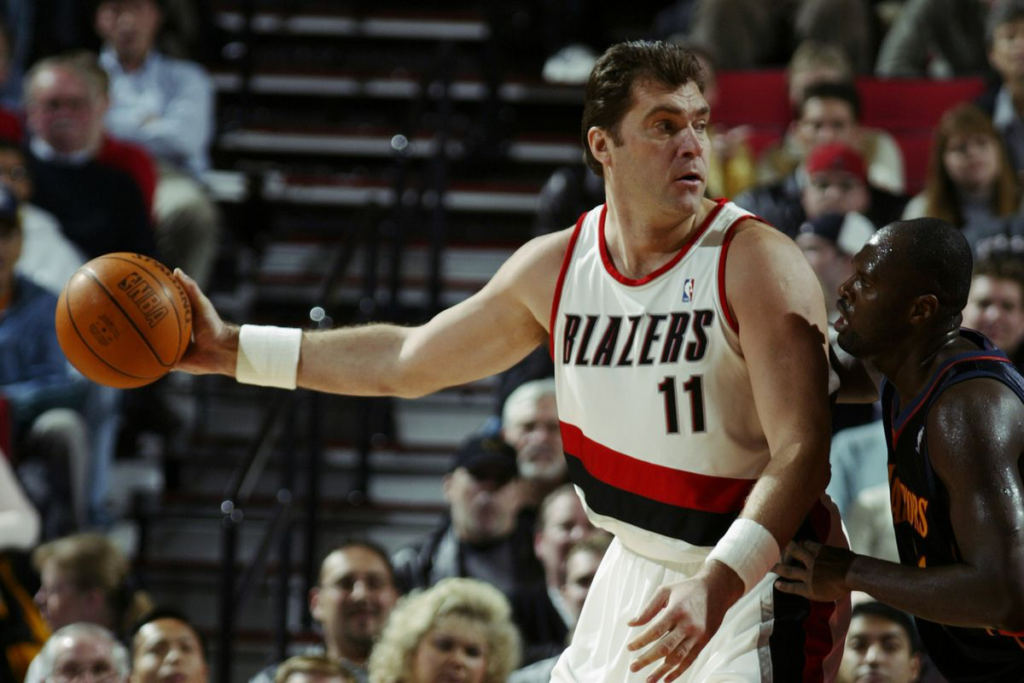
Arvydas Sabonis and Vlade Divac were two of the most skilled big men of their era, revolutionizing the center position with their unique blend of size, basketball IQ, and playmaking ability. Sabonis, known for his imposing frame and exceptional passing, played with a vision and creativity rarely seen in players of his size. His ability to make pinpoint, no-look passes from the post or beyond the three-point arc was ahead of its time, and his basketball acumen allowed him to dominate offensively and defensively. On the other hand, Vlade Divac brought finesse to the game with his fluid footwork, basketball smarts, and ability to orchestrate from the center spot. Divac’s skill set included a soft touch around the rim, excellent passing, and the rare ability to run the floor like a guard, making him a key facilitator for his teams. Both Sabonis and Divac redefined what was possible for big men, blending traditional post moves with the ability to stretch the floor and initiate offense, setting the stage for today’s modern centers who are just as likely to rack up assists as they are points.
Much like Arvydas Sabonis and Vlade Divac before him, Nikola Jokić has taken the traditional center position to new heights with his unparalleled playmaking ability. Sabonis and Divac laid the groundwork for a center who could not only dominate in the post but also facilitate offense, using their vision and basketball IQ to distribute the ball with precision. Jokić has taken that concept and fully realized it, becoming one of the most unique players in NBA history. Standing at 7 feet tall, he combines the craftiness and passing ability of a guard with the size and rebounding presence of a traditional center. His court vision and ability to make no-look passes or thread the needle from the high post have redefined what it means to be a center in today’s game. Just like Sabonis and Divac, Jokić’s skill set proves that the center position is no longer just about scoring and rebounding, but also about orchestrating the offense and setting the tempo of the game.
“Joker is incredible. Found out he was a water polo player — that’s why those one-handed passes are so elite. Bill Laimbeer couldn’t jump over a stack of quarters, but it’s all about positioning.”
“People act like it’s new… but Jordan did that shit. Magic? C’mon man. Tiny Archibald, too.”
WHY PISTONS DON’T GET THEIR DUE?
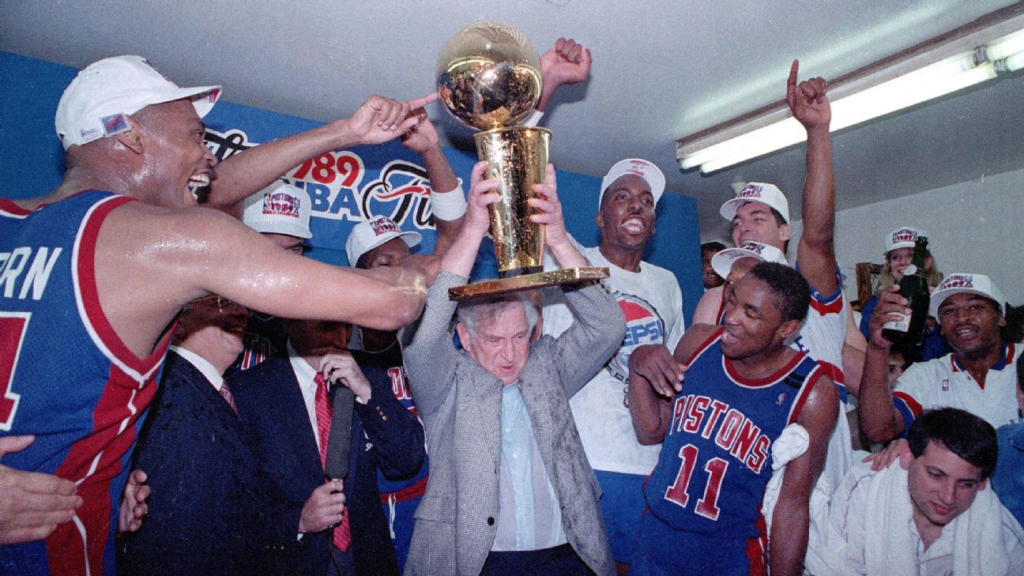
The “Bad Boys” Detroit Pistons teams of the late 1980s and early 1990s are often overlooked in discussions about NBA greatness, despite their significant impact on the league. While the Chicago Bulls and Los Angeles Lakers dominate much of the narrative surrounding that era, the Pistons were the team that truly set the tone for physicality, toughness, and defense-first basketball. With players like Isiah Thomas, Joe Dumars, Dennis Rodman, and Bill Laimbeer, the Pistons established a brand of basketball that challenged conventional play, emphasizing grit over flair. Their back-to-back championships in 1989 and 1990 proved they could compete with the best, yet they are often overshadowed by the more glamorous teams of the era. The Pistons’ hard-nosed approach to the game often got lost in the more mainstream stories of Michael Jordan’s rise and the Lakers’ Showtime era, but the Bad Boys were pioneers of a defensive-minded, team-first ethos that helped shape the evolution of the NBA. Their legacy deserves far more recognition, not only for their titles but also for their influence on how teams built their identity and approached the game in the years to come.
Rick Mahorn says the Pistons not getting the same attention as other teams doesn’t get under his skin:
“Nah, it doesn’t bother me. The Lakers and Celtics always get the spotlight. They skip over the Rockets too… but all I know is I got hardware in my house and I know I’m a champion. They can say all they want.”
Legacy Talk, Real Talk.
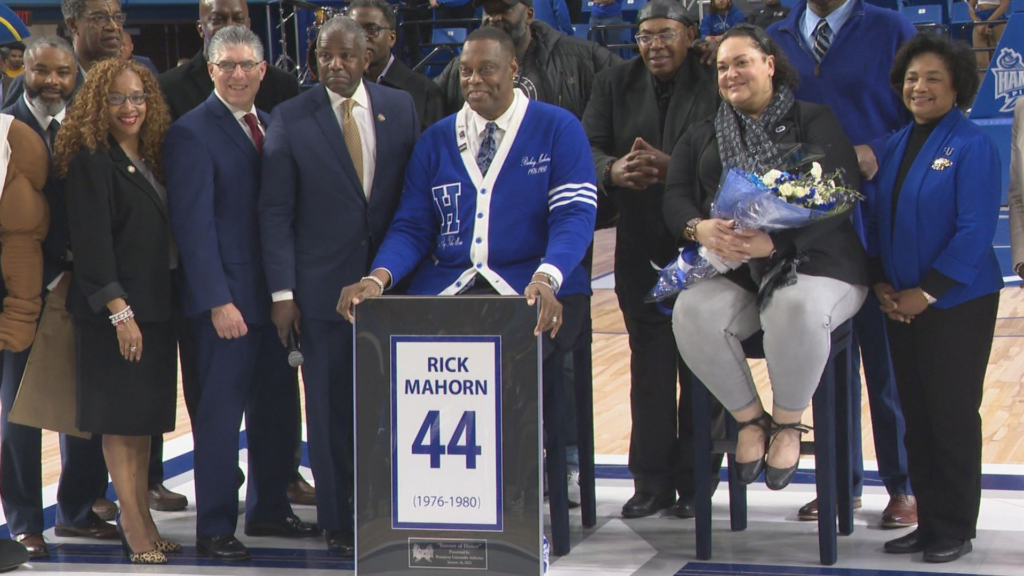
From battles in the paint to building teams in practice gyms that smelled like sweat and truckers, Rick Mahorn has seen it all. A true enforcer during the Bad Boys era, Mahorn made his living doing the dirty work—setting bone-crushing screens, protecting the rim, and defending his teammates with a bruiser’s pride. He brought that same grit with him through his stints with the Washington Bullets, the New Jersey Nets, and later into coaching, where he passed down old-school wisdom to a new-school league. His voice still carries the weight of experience—each quote a blend of unfiltered honesty and earned respect, drawn from decades of playing alongside legends and mentoring rising stars. And whether he’s on the mic or behind the scenes, Mahorn remains an enduring force in the game—teaching, reflecting, and always telling the hardwood truth, one quote at a time.
Mahorn’s journey through the NBA isn’t just about elbows and intensity—it’s about evolution. As the game transitioned from physicality to finesse, Rick adjusted, mentoring big men on how to balance strength with skill. His presence on the sidelines, especially during his time as an assistant with the WNBA’s Detroit Shock under Bill Laimbeer, reflected his commitment to growing the game at every level. Beyond the court, Mahorn has become a beloved voice in Detroit media, delivering candid commentary with the same edge he brought to the paint. His legacy is more than just the bruises he gave or the battles he won—it’s the standard he set for toughness, loyalty, and truth in a league that’s constantly rewriting itself.
